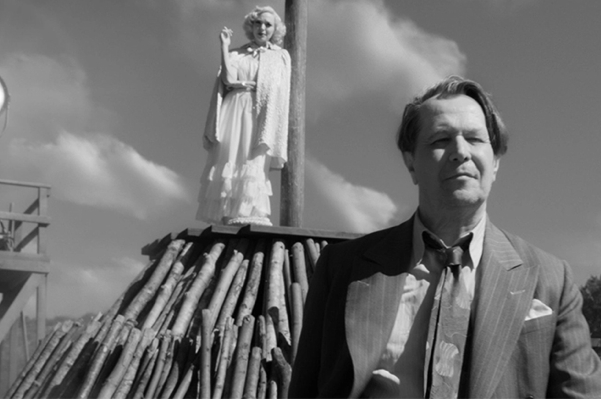
‘Mank’ tells the backstory for Herman Mankiewicz’s ‘Citizen Kane’ screenplay
By Diane Carson
Articles, books, and films have interrogated the creation of director/co-writer Orson Welles’ iconic 1941 “Citizen Kane.” Director David Fincher’s Netflix film “Mank” won’t settle any arguments given its clichéd treatment of Hollywood luminaries, with name dropping replacing complex development. Here’s the essence of this take on the troubled attribution of “Kane’s” screenplay.
Herman Mankiewicz, called Mank, is an irredeemable alcoholic with a genius for writing screenplays. Opening titles announce the Hollywood arrival of virtuoso Orson Welles enjoying carte blanche for his first film. It’s 1940 with Welles’ friend and scriptwriter Mank sequestered with an assistant and a secretary in Victorville, hypothetically a safe distance from L.A.’s booze and distractions. Nevertheless, in flashbacks to the 30s and occasionally at this desert retreat, studio icons appear: Louis B. Mayer, Irving Thalberg, producer John Houseman, Mank’s brother Joe, and co-writers Ben Hecht, Charles Lederer, George S. Kaufman, and more, all minimally beyond caricature.
The first half of this overly long, two hour eleven minute film, plays like a smug showcase for wordplay, admittedly at times quite clever. The second half feels disconnected, time jumping to reveal Mank’s antipathy to newspaper tycoon William Randolph Hearst who supports conservative gubernatorial candidate Frank Merriam running against Mank’s favorite, Upton Sinclair, championing an end poverty campaign. This explains the key, alcohol-fueled, embarrassing rant when, at Hearst Castle, Mank confronts Hearst, who’s been infusing money behind the scenes for staged testimonials.
As Mank, Gary Oldman’s performance is magnificent, especially his drunken scree. Other actors give solid support: especially Amanda Seyfried as Hearst’s mistress Marion Davies (whom Welles said he badly misrepresented), Charles Dance as Hearst, Tom Burke as Welles, and more. “Mank” is entertaining but also glib, cavalier, and trite—the alcoholic, genius writer. Yes, its old school features appeal: beautiful black and white cinematography, film reel change circles in the upper right hand corner (these indicated to projectionists the imminent end of a reel), period art direction, and several nods to “Kane” in compositions and lighting.
Yet here I must include personal experiences. I’ve taught “Citizen Kane” at least twenty times and researched it extensively. I’ve had the privilege of talking in person with “Kane’s” producer John Houseman. Without question, Welles revised Mank’s script, for which they shared an Oscar, the only one of nine nominations. Most relevant, Welles called his “Citizen Kane” Rosebud hook “dime-store Freud” and the same applies to the late Jack Fincher’s screenplay, director David’s father. And so in the tradition for the amazing “Citizen Kane,” this one will spark new disagreements and keep the tradition going. “Mank” streams on Netflix.


